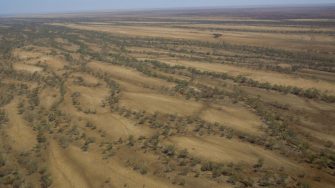
Date: Friday, October 9, 2015
Project: Eastern Australian Waterbird Survey
Observer: Terry Korn
We had a long day in the plane today but only a few wetlands, as we headed east along band 9, before overnighting in Rockhampton. Strong easterly headwinds extended what is traditionally one of our longest survey days over highly variable country, some of which has been grazed conservatively but much of it not so. This leg takes us over the upper reaches of two of the three famous Channel Country Rivers, the Georgina and the Diamantina.
The Georgina River is the most westerly of the two and we started on a few of its more persistent waterholes, which always have water but generally not large numbers of waterbirds because these waterholes are steep sided with deep water. They tend to produce limited food for the ducks, unlike shallow wetlands. Pelicans and cormorants, the fishing birds, tend to favour such places.
Battling at a maximum of 90 knots/hr, we headed east over endlessly dry country before eventually reaching Winton to refuel the plane and ourselves, after more than 3.5 hrs. A neat little airport proudly announces Winton as the founding home of Qantas in 1920 and the first locally funded and built airfield in Australia in 1921 to assist Qantas begin its climb to the top group of international carriers. Winton is also famous for its fossil fields of dinosaurs, something the airport proudly announces with garbage bins dressed up as big carnivorous dinosaur feet.
After lunch, and east of Winton, there are two natural lakes, Lakes Galilee and Dunn. The former is a large shallow salt lake that is a haven for many species of waterbirds when it has water. Sadly it was empty this year but in past years we have counted up to 150000 grey teal on the 50% of lake within the band. There are also large numbers of other waterbird species which feast on the lake in good times. South of Lake Galilee, near the bottom of our 30km wide survey band is Lake Dunn, a freshwater lake which is rarely dry and it didn’t disappoint this year. Pelicans, brolgas, Pacific black duck, black-winged stilt and grey teal were dominant but only in small numbers as freshwater lakes are not as productive as salt lakes.
Lake Dunn 9 October 2015. Photo: Terry Korn
Pelicans over Lake Dunn. Photo Mark Ziembicki
Hamilton River floodplain. Photo Mark Ziembicki
The day was finished in the Bowen Basin coal fields where open cut coal mines stretch for many kilometres in a north/south direction. Very little water has persisted in the natural water courses east of these. Here, farm dams are a major haven for waterbirds, particularly brolgas with groups of 30-50 common around water or in the surrounding paddocks.
Saturday is our rest day in Rockhampton when we catch up with transcribing our tapes, transferring data, keeping up with emails and domestic chores such as washing. On Sunday, we head west along Band 8, crossing the third of the iconic Channel Country streams Coopers Creek which has the most variable flow of any major river in the world. Coopers Creek is formed by two rivers, the Thomson and Barcoo Rivers.
